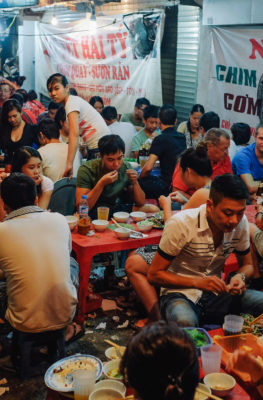Published on July 17, 2015
Pie tee. Image © Mike Aquino
The Peranakan people could only have come from Southeast Asia. Descended from the ancient intermarriage between visiting Chinese traders and women from the Malay and Javanese communities they did business in, the Peranakan brought together two separate cultures and created another.
Out of their Malay and Chinese roots came the Peranakan’s business savvy, cultural eclecticism, and appreciation for art and cuisine – all of which shaped their food, language, business, and way of life, in turn influencing the communities they called home.
The Peranakan are most famous for their food. Centuries of blending local custom with those of their Chinese ancestors have helped the Peranakan produce dishes that excite the taste buds and satisfy the soul.
“Nyonyas”, as Peranakan ladies are called, perfected Peranakan cuisine over the generations. Today’s Peranakan dishes are family recipes handed down through the centuries: the best Peranakan restaurants take great care to reference their home-cooked roots, giving the impression that you’re an important guest and the Nyonya’s made you something special.
So let’s say you’re striding down the George Town, Penang heritage trail, or visiting the Peranakan home grounds in Joo Chiat in Singapore, or just finished visiting the Benteng Heritage Museum near Jakarta and raring to try what the Nyonyas and Babas (male Peranakan) had for dinner – what then?
Simple: visit a Peranakan restaurant or hawker stall and try the following items on the menu:
Loh bak. Image © Mike Aquino
Loh bak. Nyonyas don’t waste anything in the kitchen, so they took beancurd skin (a byproduct of making tofu) and wrapped it around meat for frying. This resulted in the dish we now call loh bak – the addition of Chinese five-spice powder creates an aroma and flavor that complement the savoriness of the chicken or pork and deep-fried beancurd skin.
Laksa. The Peranakan’s favorite noodle dish comes to you drenched in a tamarind and lemongrass infused coconut milk curry, with egg, shrimp, cockles, garlic, shrimp, tofu and shredded chicken added in varying proportions (laksa is famous for its regional variations).
Nasi ulam. translating to “rice with raw vegetables”, nasi ulam is a favorite rice accompaniment to many traditional Peranakan dishes. The dish consists of rice combined with spices and finely julienned herbs: additions may include kaffir lime leaf, shallots, turmeric, and the Peranakan shrimp paste called cincalok.
Nasi ulam. Image © Mike Aquino
Ayam buah keluak. Its strong flavor might put some off, but the complexity of this chicken stew commands the loyalty of generations of Peranakan. Making ayam buah keluak often takes the better part of the day, as Nyonyas prepare the spices, the keluak nuts and the chicken all by themselves, with the final simmer taking up to half a day by itself.
Pongteh. This dish keeps very well, even unrefrigerated… and the longer it keeps, the better it tastes. Pongteh consists of either pork or chicken braised in a mix of soybean paste and finely-chopped shallots and garlic, and fortified with black mushroom and potatoes. Drizzle the sauce over rice as you eat your pongteh; the flavor is just awesome.
Kueh. One word encapsulates a riotous variety of cakes and tarts, both of the savory and sweet persuasion. One of the most popular variants is pie tee, a tart shell topped with vegetables and prawn. Formerly made only on special occasions, Peranakan restaurants now serve this treat year-round.






